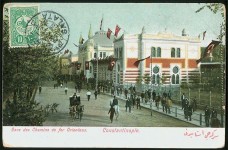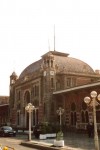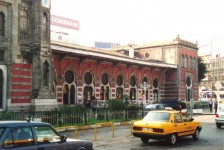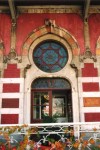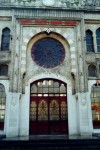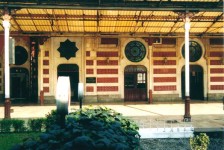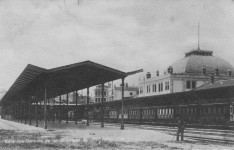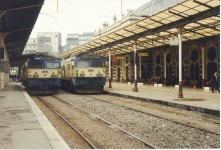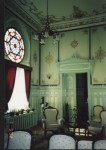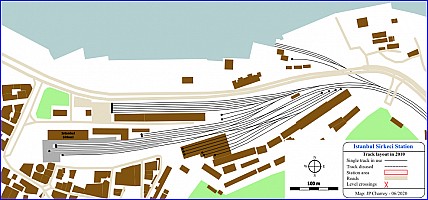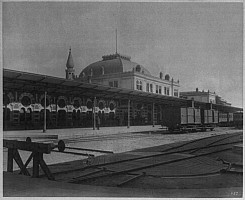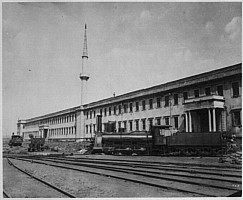Istanbul - Sirkeci
The first railway station on the European shore Istanbul was located in Yedikule and started to operate in January 1871 when the Chemins de fer Orientaux opened the line to Küçük Cekmece, the fist part of IstanbulEdirne? line.
Soon, the line was extended towards the Golden Horn and a new terminal station was built for the opening of the extension to Edirne in 1873. the Ottomans selected a prime piece of land at the foot of the Sultan palace to establish this station. It is very near to Galata bridge, giving easy access to the old Istanbul city center like the Great Bazar. It is also very near to the Galata bridge crossing to the other side of the Golden Horn, where the European embassies and the modern hotels such as the Pera Palas and the Tokatlian hotel were located. It is said that the Sultan himself gave the land for the station. However, this site is very much constrained by the Golden Horn on one side, a hill on the other side, giving little room left for the railway. For this reason, the main yard and maintenance facilities where moved out to Halkali?, far out of city at the time.
The first building known as "temporary" was replaced by the current Sirkeci station building on 3 may 1890. This change was decided so that the passengers of the Orient Express could arrive and depart in a setting worthy of the luxury of the train itself. Tenders for the design of a large station were thus called and the works were awarded to Jasmund, a German architect. He created for the occasion an "orientalist style" that was greatly admired, and influenced the designs of other architects. But the building was also modern, having gas lighting and heating in winter.
The last gap to Europe was plugged on 1st June 1889 with opening of the line between Sofia and Nis. Through Orient-Express began running immediately afterward and the first passengers did arrive in the temporary station before being able to enjoy Sirkeci station.
The current building has been preserved in its original state. Inside, one can easily imagine the ambiance at the departure of the Simplon Orient Express in 1920. But the station surroundings changed very much since 1890. In those days there were hardly any buildings around. The passengers were in pleasant setting of garden and trees, with the ground descending in terraces to the sea. Today the station stands in a chaos of cars and concrete. A gas station is right in front of the station and the seashore is now one of Istanbul main road corridor. The gardens have been turned into parking lots.
Istanbul Sirkeci and Haydarpaşa stations used to be linked by a train-ferry boat.
Track plan
The tracks and the building are located on a narrow strip of land between the sea and the Topkapi Palace. This land is in East - West alignment, but the train are exiting on the East side. Then a series of curves around the city and following the sea will allow the train to make a U turn and take their course toward the West.
In the early days, the station had 2 platforms: the main one in front of the building and a secondary one, each served by a single track. In between those two tracks, there were some more tracks used to park railway cars. Communication between the tracks was done with sets of turntables. Those centrals tracks have been replaced by a central Platform served by 2 tracks, giving present day configuration. This central platform was used for suburbs trains, while the main platform in front of the station was used for long distance trains.
The station had a small turntable and a few tracks to service steam engines in front of the building of the military medical schools which predates the railway. This turntable was removed during the electrification works 1954-1955 to make for stabling facilities for the EMUs. The main facilities for engine servicing were located 7km away, in Yedikule, on a large piece of land which was pretty much country side in those days.
On the other side, the station had a freight facility with a yard, freight platform & sheds and tracks reaching the quays, next to the boats. This facility was gradually reduced from the 1970s to disappear sometime in the late 1990s. The freight facility was transferred to Halkali.

